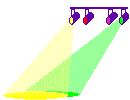nannamom
Admin


Number of posts : 2210
Age : 66
Humor : Once you choose hope, anything’s possible. -Christopher Reeve
Registration date : 2008-11-09
 |  Subject: News Release from SAMSHA Subject: News Release from SAMSHA  Wed 16 Sep 2009, 11:44 am Wed 16 Sep 2009, 11:44 am | |
| 
Date: 9/10/2009
Media Contact: SAMHSA Press
Telephone: 240-276-2130
New National Survey Reveals Significant Decline in the Misuse of Prescription Drugs
Sharp decline also continues for methamphetamine use
The misuse of prescription drugs decreased significantly between 2007 and 2008 among those aged 12 and older, including among adolescents, according to 2008 National Survey on Drug Use and Health (NSDUH). However, the national survey showed that the overall level of current illicit drug use has remained level at about 8 percent.
The annual NSDUH report which was issued by the Substance Abuse and Mental Health Services Administration (SAMHSA) of the U.S. Department of Health and Human Services at the start of the 20th annual National Alcohol and Drug Addiction Recovery Month (Recovery Month) also indicated that progress has been made in curbing other types of the illicit drug use. For example, past month methamphetamine use among those aged 12 and older dropped sharply from approximately 529,000 people in 2007 to 314,000 in 2008. Similarly, the level of current cocaine use among the population aged 12 and older has decreased from 1.0 percent in 2006 to 0.7 percent in 2008.
Promising results from the latest survey also were also found for the most part among youth (12 to 17 year olds). Among youth there was a significant decline in overall past month illicit drug use, from 11.6 percent in 2002 to 9.3 percent in 2008. Although the rate of current marijuana use among youth has remained level at about 6.7 percent over the past few years there have been significant decreases in the current use of alcohol, cigarettes and non-medical use of prescription drugs since 2007. Non-medical use of prescription drugs dropped from 3.3 percent in 2007 to 2.9 percent in 2008.
Historically, young adults have had the highest rates of substance abuse, and for most types of illicit substance abuse the levels have remained steady over the past year. However, over the past three years there has been a steady drop in the rate of heavy alcohol use by full time college students aged 18 to 22 – from a high of 19.5 percent in 2005 to 16.3 percent in 2008.
“The results of this survey underscore the progress made and challenges we face as we observe the 20th anniversary of Recovery Month,” said SAMHSA Acting Administrator Eric Broderick, D.D.S., M.P.H. “While we have made progress on many fronts, declines in marijuana use among youth have stalled out, and the rates of illicit drug use among young adults have not budged for years.”
“The survey findings are important because they often point to emerging patterns of substance abuse,” said Gil Kerlikowske, Director of National Drug Control Policy. “Although we see some success reversing trends in prescription drug abuse, there are indications that progress in other areas may be at a standstill, or even slipping back, particularly among youth. As we develop the Obama Administration’s first drug control strategy, we will emphasize a balanced approach that can respond to current and emerging drug abuse trends. Improving substance abuse prevention and treatment systems will be among our priorities.”
Despite many positive trends, the most recent NSDUH survey also reveals continuing problems and setbacks. For example there were significant increases in the rates of Ecstasy and LSD use among youth over past few years. The level of past year Ecstasy use in 2008 for youth was 1.4 percent – lower than the 2.2 percent in 2002, but higher than the lowest level of 1.0 percent reported in 2005. Likewise, the 2008 level of past year LSD among youth of 0.7 percent, while lower than the 2002 level of 1.3 percent in 2002, is significantly higher than the lowest use rate of 0.4 percent reported in 2006.
Perhaps most notable, in view of the 20th anniversary of Recovery Month, this year’s NSDUH also continues to show a vast disparity between the number of number of people needing specialized treatment for a substance abuse problem and the number who actually receive it. According to the survey 23.1 million Americans need specialized treatment for a substance abuse problem, but only 2.3 million (or roughly 10 percent of them) get it.
NSDUH is a scientifically conducted annual survey of approximately 67,500 people throughout the country. Because of its statistical power, it is a primary source of information on the levels of illicit drug, alcohol, and tobacco use as well as certain mental health conditions.
The complete survey findings are available on the SAMHSA Web site at http://oas.samhsa.gov/nsduh/2k8nsduh/2k8Results.cfm. Copies may also be obtained free of charge by calling SAMHSA’s Health Information Network at 1-877-SAMHSA-7 (1-877-726-4727) or at http://ncadistore.samhsa.gov/catalog/productDetails.aspx?ProductID=18177National Alcohol and Drug Addiction Recovery Month recognizes the accomplishments of people in recovery, the contributions of treatment providers and advances in substance abuse treatment and recovery throughout the nation. Electronic versions of Recovery Month materials are available at http://www.recoverymonth.gov. The kit is downloadable at
http://www.recoverymonth.gov/Recovery-Month-Kit.aspx.
Please visit http://www.samhsa.gov/newsroom/advisories/090910NSDUH)5111.aspx for additional details
Article Source:Please visit Recovery Month Press RoomPosted by:Dee09/16/09 | |
|
